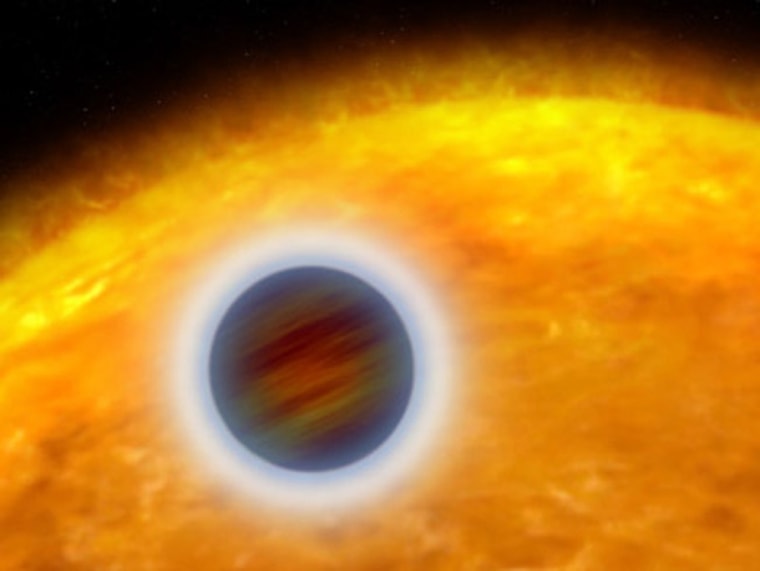One of the biggest risk-takers in the planetworld orbits so close to its parent star that its upper atmosphere bleeds into space like high-speed steam rising from a boiler. Now astronomers have measured the “layer-cake” structure of the extrasolar planet’s heated atmosphere.
Like a freshly-made cotton candy, HD 209458b is so hot that its atmosphere appears to be puffed up. The Jupiter-size planet is just 4.4 million miles (7 million kilometers) from its star, or 20 times closer than the Earth is to our sun, and about 100 times closer than Jupiter is to our Sun, hence the nickname of “hot Jupiter” for extrasolar planets this big and close to their parent stars.
The new study, detailed in the Feb. 1 issue of the journal Nature, could shed light on other hot Jupiters.
"This planet's extreme atmosphere could yield insights into the atmospheres of other hot Jupiters," said lead scientist Gilda Ballester of the University of Arizona in Tucson.
Light filter
With the Hubble Space Telescope, astronomers measured starlight that filtered through the planet's puffy outer atmosphere. Astronomers can calculate an atmosphere’s structure and chemical make-up by studying how starlight filters through it.
"The layer we studied is actually a transition zone where the temperature skyrockets from about 1,340 degrees Fahrenheit (1,000 Kelvin) to about 25,540 degrees (15,000 Kelvin), which is hotter than the sun," Ballester said. "With this detection we see the details of how a planet loses its atmosphere."
They observed that ultraviolet radiation from the host star bakes the hydrogen gas in the upper atmosphere, causing it to balloon. With such an intense heat source, the gas streams from the planet’s gravitational pull at a rate of 10,000 tons a second, or three times the rate of water flowing over Niagara Falls.
Even still, astronomers don’t expect the planet to fade away any time soon. It has a prognosis of 5 billion years or more.
Hot insights
Discovered in 1999, HD 209458b is one of a few known alien worlds that can be observed as it transits its parent star, called HD 209458. With a 3.5-day orbit, HD 209458b is 150 light-years from Earth in the constellation Pegasus.
Astronomers estimate about 10 to 15 percent of the more than 200 known extrasolar planets are hot Jupiters like HD 209458b. A recent Hubble survey revealed 16 hot Jupiter candidates in our Milky Way Galaxy, which suggests there might be billions of these gassy star-huggers in our galaxy.
Previous Hubble observations revealed oxygen, carbon, and sodium in HD 209458b's atmosphere, as well as in its fan-like tail. Those findings combined with the new ones provide the first detection of the chemical makeup of an extrasolar planet's atmosphere.
